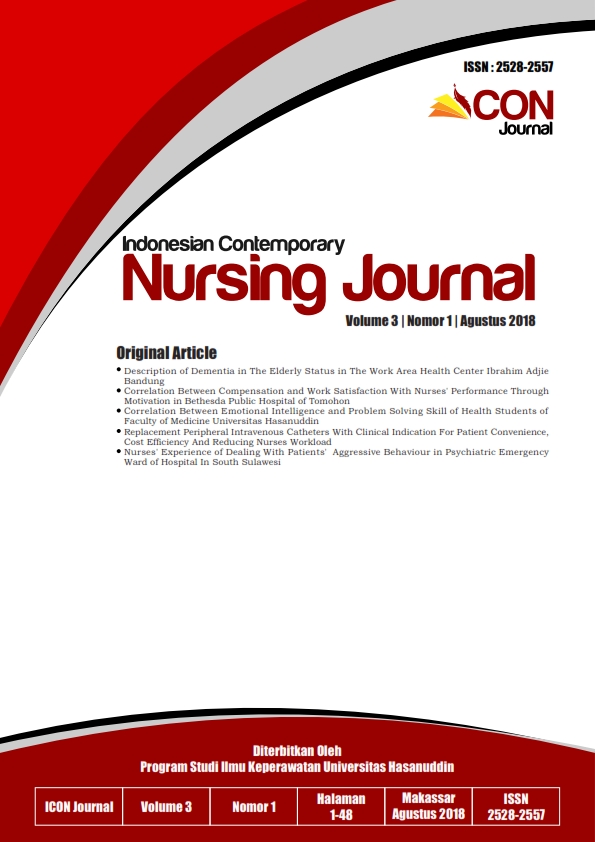Replacement Peripheral Intravenous Catheters With Clinical Indication for Patient Convenience, Cost Efficiency and Reducing Nurses Workload
DOI:
https://doi.org/10.20956/icon.v3i1.3675Abstract
Introduction: PIVCs (Peripheral Intravenous Catheters) have been widely used for clinical medical care which is having risk for phlebitis occurence. IV catheter replacement is performed when there is clinical indication such us phlebitis. The consequence of this action is patient convinence, nurse workload and patient care cost efficiency. Methode: A longitudinal study with experimental results of evidence based practice on replacement of PIVSc with clinical indication as an effort to improve patient convinience, cost efficiency and reduce nurse workload in 41 patients. Result: 41 patients attached PIVCs, 100% wanted IV catheter replacement if there was any clinical indication. 68% of patients said very uncomfortable if IV catheter routinely replaced. 16 nurse (56.25%) said there is no need to replace IV catheter regularly. 43.75% of nurses felt IV catheters rountine replacement increased the working time and 50% of the nurses felt that nurses workload was increased. Conclusions: IV catheter replacement can be performed if there is cinical indication because it can improve patient convenience, increase cost efficiency and reduce nurse workload.
References
Alekseyev, S., Byrne, M., Carpenter, A., Franker, C., Kidd, C., & Hulton, L. (2012). Prolonging the life of a patient’s IV: an integrative review of intravenous securement devices. Medsurg Nursing, 21(5), 285–92.
Caruana, E. J., Roman, M., Hernández-Sánchez, J., & Solli, P. (2015). Longitudinal studies. Journal of Thoracic Disease, 7(11), E537–E540. https://doi.org/10.3978/j.issn.2072-1439.2015.10.63
Cicolini, G., Manzoli, L., Simonetti, V., Flacco, M. E., Comparcini, D., Capasso, L., … Elfarouki, G. E. (2014). Phlebitis risk varies by peripheral venous catheter site and increases after 96 hours : a large multi-centre prospective study. https://doi.org/10.1111/jan.12403
Danski, M. T. R., Oliveira, G. L. R. de, Johann, D. A., Pedrolo, E., & Vayego, S. A. (2015). Incidence of local complications in peripheral venous catheters and associated risk factors. Acta Paul Enferm, 28(6), 517–523. https://doi.org/10.1590/1982-0194201500087
Donk, P. V., Rickard, C. M., McGrail, M. R., & Doolan, G. (2009). Routine Replacement versus Clinical Monitoring of Peripheral Intravenous Catheters in a Regional Hospital in the Home Program: A Randomized Controlled Trial, (December 2014). https://doi.org/10.1086/599776
Dychter, S. S., Gold, D. A., Carson, D., & Haller, M. (2012). Intravenous therapy: A review of complications and economic considerations of peripheral access. Journal of Infusion Nursing, 35(2), 84–91. https://doi.org/10.1097/NAN.0b013e31824237ce
Gorski, L., Hadaway, L., Hagle, M. E., McGoldrick, M., Orr, M., & Doellman, D. (2016). Infusion Therapy Standards of Practice. Journal of Infusion Nursing, 39(1). Retrieved from www.journalofi nfusionnursing.com%0AInfusion
Gorski, L., & Phillips, L. D. (2014). Manual of I.V. Therapeutics: Evidence-Based Practice for Infusion Therapy 6th Edition (6th Editio). Philadelphia: Davis Company.
Jacob, A., R, R., & Tarachnand, J. (2014). Buku ajar clinical nursing procedures (2nd ed.). Tangeran Selatan: Binarupa Aksara.
Keogh, S. (2013). New research: Change peripheral intravenous catheters as clinically indicated, not routinely. JAVA - Journal of the Association for Vascular Access, 18(3), 153–154. https://doi.org/10.1016/j.java.2013.03.005
McCallum, L., & Higgins, D. (2012). Care of peripheral venous cannula sites. Nursing Times, 108(34–35), 12, 14–5. https://doi.org/10.1016/j.java.2014.09.001
Morrison, K., & Holt, P. K. E. (2015). The Effectiveness of Clinically Indicated Replacement of Peripheral Intravenous Catheters : An Evidence Review With Implications for Clinical Practice, (2011), 187–198. https://doi.org/10.1111/wvn.12102
Pasalioglu, K. B., & Kaya, H. (2014). Catheter indwell time and phlebitis development during peripheral intravenous catheter administration, 30(4), 725–730. https://doi.org/10.12669/pjms.304.5067
RCN (Royal College of Nursing). (2010). Standards for infusion therapy. Retrieved from www.npsa.nhs.uk
Rickard, C. M., Marsh, N., Webster, J., Playford, E. G., McGrail, M. R., Larsen, E., … Fraser, J. F. (2015). Securing All intraVenous devices Effectively in hospitalised patients—the SAVE trial: study protocol for a multicentre randomised controlled trial. BMJ Open, 5(9), e008689. https://doi.org/10.1136/bmjopen-2015-008689
Rickard, C. M., McCann, D., Munnings, J., & McGrail, M. R. (2010). Routine resite of peripheral intravenous devices every 3 days did not reduce complications compared with clinically indicated resite:a randomised controlled trial. BMC Medicine, 8(2), 53–62. https://doi.org/10.1186/1741-7015-8-53
Rickard, C. M., Webster, J., Wallis, M. C., Marsh, N., McGrail, M. R., French, V., … Whitby, M. (2012). Routine versus clinically indicated replacement of peripheral intravenous catheters: A randomised controlled equivalence trial. The Lancet, 380(9847), 1066–1074. https://doi.org/10.1016/S0140-6736(12)61082-4
Webster, J., Clarke, S., Paterson, D., Hutton, A., Dyk, S. v., Gale, C., & Hopkins, T. (2008). Routine care of peripheral intravenous catheters versus clinically indicated replacement: randomised controlled trial. Bmj, 337(jul08 1), a339–a339. https://doi.org/10.1136/bmj.a339
Wu, M. A., & Casella, F. (2013). Is clinically indicated replacement of peripheral catheters as safe as routine replacement in preventing phlebitis and other complications? Internal and Emergency Medicine, 8(5), 443–444. https://doi.org/10.1007/s11739-013-0940-z
Xu, L., Hu, Y., Huang, X., Fu, J., & Zhang, J. (2017). Clinically indicated replacement versus routine replacement of peripheral venous catheters in adults: A nonblinded, cluster-randomized trial in China. International Journal of Nursing Practice, 1–8. https://doi.org/10.1111/ijn.12595
Downloads
Published
How to Cite
Issue
Section
License
Authors who publish with this journal agree to the following terms:Authors retain copyright and grant the journal right of first publication with the work simultaneously licensed under a Creative Commons Attribution License that allows others to share the work with an acknowledgement of the work's authorship and initial publication in this journal.
Authors are able to enter into separate, additional contractual arrangements for the non-exclusive distribution of the journal's published version of the work (e.g., post it to an institutional repository or publish it in a book), with an acknowledgement of its initial publication in this journal.
Authors are permitted and encouraged to post their work online (e.g., in institutional repositories or on their website) prior to and during the submission process, as it can lead to productive exchanges, as well as earlier and greater citation of published work (See The Effect of Open Access).



